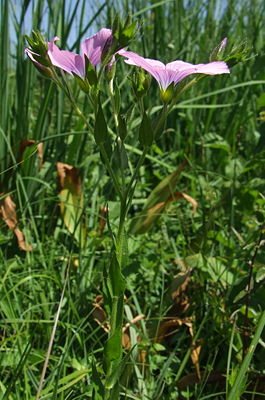Sticky flax
| Sticky flax | ||||||||||||
|---|---|---|---|---|---|---|---|---|---|---|---|---|

Sticky flax ( Linum viscosum ) |
||||||||||||
| Systematics | ||||||||||||
|
||||||||||||
| Scientific name | ||||||||||||
| Linum viscosum | ||||||||||||
| L. |
The sticky flax ( Linum viscosum ) is a plant species from the genus flax ( Linum ). It is native to the mountain regions of southern Central and South to Southeast Europe .
description
Appearance and foliage leaf
The sticky flax grows as a perennial herbaceous plant that usually reaches heights of 30 to 50, rarely up to 60 centimeters. It forms a spindle-shaped taproot . There are clumps formed with numerous stalks. The upright or arching ascending stem is very protruding shaggy hair. The only ones of the large-flowered flax species are glandular hairs, which makes the plant feel slightly sticky, hence the common name sticky flax.
The alternate on the stem upright protruding leaves are very variable. The middle stalk leaves are 5 to 9 mm wide and have egg-lanceolate leaf blades with three to five veins ; they are ciliate except at their base.
Flowers, fruits and seeds
The flowering period extends from June to July. The hermaphroditic flowers are radial symmetry and five-fold with a double flower envelope . The five 5 to 7 mm long sepals are shaggy and ciliate on the edge. The five free, 1.8 to 2.5 cm long petals are bright pink with dark red veins that turn blue when dry. The corolla has a diameter of 3.5 to 5 cm.
The five- chamber capsule fruit contains ten seeds. The smooth, light brown seeds are relatively large and elliptical.
Chromosome number
The number of chromosomes is 2n = 16.
Occurrence and protection
The sticky flax is native to southern central Europe and southern Europe . It thrives in mountainous areas in northern and central Spain, as well as in the Pyrenees and in small deposits in Portugal. It occurs in the Apennines and in the northwestern Balkans, in Croatia and Hungary. In the Alps, sticky flax occurs in the southern and northern limestone Alps and parts of the eastern and south-eastern Alps.
The sticky flax thrives on the north side of the Alps only in the Bavarian foothills of the Alps. The sticky flax immigrated through the spread of seeds using the Lech as a flora bridge and became at home on so-called heat islands. In Germany, sticky flax is limited to a few special locations in Bavaria; you can find it on the Ammer Mountains or the Lechtalheiden . The sticky flax is protected in Germany; Red List 1996: Level 3 = endangered. In Germany, sticky flax is spreading locally due to nature conservation measures.
The sticky flax thrives on fresh to moderately dry, but also on alternately dry to alternately moist, lime-rich soils . The Sticky Lein is on dry grassland , neglected grassland , calcareous grasslands or gravel base before. The sticky flax occurs scattered or rarely. It is locally a type of character of the Gentiano-Koelerietum from the Mesobromion Association, but also occurs in other societies of the Mesobromion or Molinion associations and is a supra-regional type of the order Brometalia.
See also
swell
- Burkard Quiniger, 2010: Information sheet on species protection 30 - Sticky flax - Linum viscosum L. from the Bavarian State Office for Environmental Protection as PDF.
Individual evidence
- ↑ a b Erich Oberdorfer : Plant-sociological excursion flora for Germany and neighboring areas . 8th edition. Verlag Eugen Ulmer, Stuttgart 2001, ISBN 3-8001-3131-5 . Page 631.

